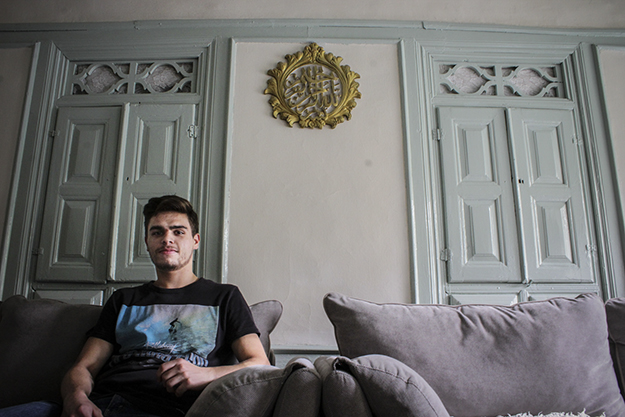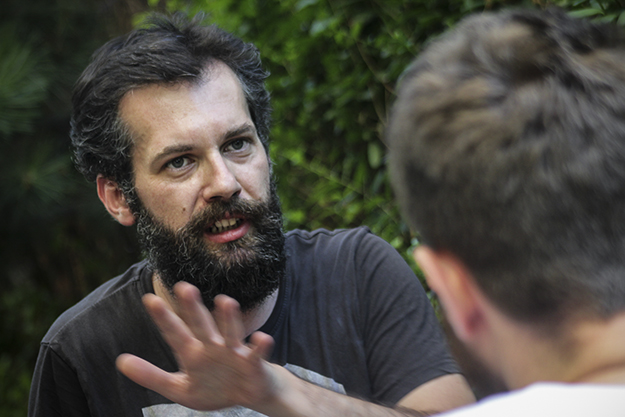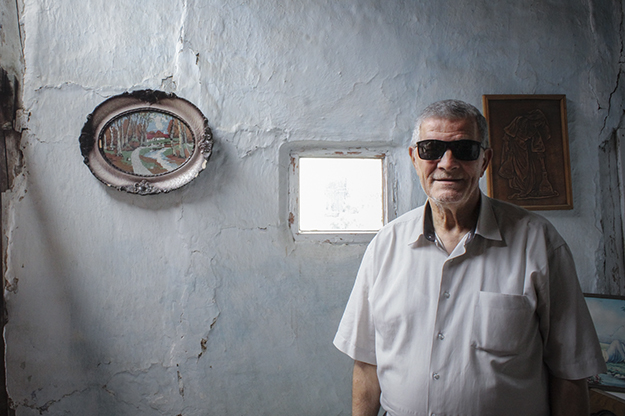Izet Mashkulli proudly gives a tour of the house to K2.0, inviting us to enter through the narrow doorway, and continuously saying “mind your head or you’ll hit the lights,” which are positioned in such a way so as to give you the impression that you’re walking through a tunnel.
Izet tries to get everyone’s attention by showing them the ceiling, which is decorated with wood and is notable for the metallic equipment that hangs down from it, once used to rock baby cradles. A smiling Izet presents the windows, which are covered with metal grates, and seem to protect the house from any outside attention. Inside, just about every room has its own hamamgjik (bath), each so small that they could barely fit a person.
Eighteen-year-old Izet knows all these features of the house — believed to have been built at some point in the beginning of the 19th century and which has an Ottoman architectural style — almost by heart, and he often presents them to visiting tourists. The Mashkulli family have a memorandum of understanding with certain organizations that send visitors there. Besides the family home, visitors can also see the League of Prizren complex and the Gazi Mehmed Pasha Mosque; all three of these cultural heritage sites are situated next to one another.

Izet Mashkulli has built his life around his house and dismisses any idea of selling it. Photo: Agan Kosumi / K2.0.
The house is protected as a cultural heritage site by law and is functional to this day. Izet lives there together with his parents and his two brothers. The Mashkulli family has received big offers from people wishing to buy the house, which they inherited from their ancestors, but the parents decided to give it to their children.
Izet completely agrees with his parents’ decision. To him, the house is not only important because of his ancestors’ history, but also because he has spent his whole life there. Everything about it reminds him of his most memorable experiences since his early childhood. Although Izet is unemployed and currently attending an intensive hairdressing course, his connection with the house is too strong for him to consider selling it, despite the fact that it would improve his family’s economic situation.
According to Hajrullah Ceku, a member of NGO EC Ma Ndryshe, which advocates for the protection of cultural heritage, the memories that these sites hold push people to preserve them:
“Memory is what we are. It is a part of our identity. Without memory, we have no identity, and if we preserve our cultural heritage, then we preserve our memory,” Ceku says. “I’m talking more about local identities, neighborhood identities, and their preservation. Old buildings are not valuable just because they are old. Their value exists because of the connection that they have with the people around them.”
For Ceku, any damage inflicted upon cultural heritage sites is an attack against people’s memory. For him, a recent intervention at the dome of the 16th century Prizren Hamam — one of the most important buildings in the city — illustrates the connection between memory and cultural heritage.
In 2014, after receiving a donation from UNESCO and with the supervision of Turkish experts, small interventions were made in the hamam, including to its roof. Based on archives that date back more than 200 years, restoration experts decided to change the building material of the dome of the hamam, namely to use the building material that was used originally. However, Ceku says that this resulted in a civil reaction, seeing that the original domes were not a part of their memory.

Hajrullah Ceku says that memory is what we are. According to him, identity cannot exist without memory, and if we preserve cultural heritage sites, then we also preserve our memory. Photo: Agan Kosumi / K2.0.
“So people reacted because they saw a foreign body,” he says. “The gene of memory and identity was activated, and they said, ‘What is this thing? We didn’t grow up with this hamam.’ Older people reacted most, indicating that the intervention that was to be made was not associated with the memory that people had of this hamam — even the elderly.”
Ceku insists that for citizens, it is not important how we build buildings, how old they are, or what architectural values they have. People care more about the memories that these buildings offer, as in the case of the hamam dome, in which people did not care that “the original building material of the dome was being restored.”
By working in the field, Ceku changed his own preconception that citizens do not have any affinity for cultural heritage sites. He has seen the people insist for these buildings to be preserved more than any institution has done.
The recent case at the Vushtrri Castle is a concrete example of what Ceku alludes to. There too, the people were the ones that stood up to protect cultural heritage sites. During July, the Institute for the Protection of Monuments within the Ministry of Culture issued a permit that allowed the transformation of the castle into a restaurant.
However, this decision mobilized citizens and civil society, who gathered to strongly oppose this potential move. They asserted that all of this was being done so that people who are closely affiliated with the government would benefit financially; in fact, the person who had received the permit for intervention in the castle was closely linked with the head of the Municipality of Vushtrri, Bajram Mulaku.
Ceku says that while the relationship of citizens toward cultural heritage objects has been more orientated toward spiritual values such as memory and identity, which “is to be appreciated,” the same cannot be said for state institutions.
“Local institutions have not taken any measures to preserve cultural heritage sites,” he says. “They’ve only compiled lists of cultural heritage sites, and have not done anything subsequently. They have not thought about anything else.”
The degradation of cultural heritage attracted attention particularly in the summer of 2016, when the negligence and lack of action on the institutions’ part led to the tragic death of Xheneta Gashi. The 3-year-old girl died when the ceiling of her house, which is part of the cultural heritage of the protected Historic Center of Prizren, fell in on her after heavy rainfall. The Municipality of Prizren had been warned by NGOs and the Regional Center for Cultural Heritage in Prizren (which operates as a branch of the Ministry of Culture) about the risk posed by houses in Marin Barleti street, after another house had collapsed on the same road a month before. However, they did not take any measures to mitigate this risk.
Musicians Iljaz and Shukrie Morina live a few meters down from where Xheneta lived in Marin Barleti street. Unlike the Mashkulli family, they have decided to sell their house — which is more than 100 years old — seeing that it is uninhabitable. Recently the Regional Center for Cultural Heritage in Prizren came to their aid and decided to restore the house.

Iljaz Morina does not believe that the help offered by state institutions is sufficient to make the house habitable. Photo: Agan Kosumi / K2.0.
However Iljaz says that few interventions have been made in the house throughout the years and sees the help that was offered recently by state institutions as insufficient. According to him, this aid is not enough to fix all the damage that this house has endured throughout its long history, because “all they offered was to paint the walls.”
Shukrije says that selling the house had never previously crossed their minds. She nostalgically recalls the connection that the couple have created with their house, and with their neighbors, which she mentions continuously. However, Iljaz’s poor state of health leaves them no other alternative. They say that it is impossible to heat the house during winter, whereas during summer the heat is unbearable.
They are convinced that if they sell the house, the potential buyers will destroy it and build something else, since their house is not on the list of protected buildings, and the idea of this upsets them.
Statehood and economic development against cultural heritage
For Florina Jerliu, a University of Prishtina professor who teaches a course titled “Protection of Cultural Heritage,” the state must protect cultural heritage because it is closely connected with “the historical continuation of society” and it affects not only family or neighborhood identities, but also the identity of the state itself.
Jerliu says that the element of statebuilding must motivate people to preserve cultural heritage sites. She mentions the examples of European countries like France, Great Britain and Germany, which see cultural heritage as a key element for creating a common social identity, which aids the formation of the state.

Florina Jerliu believes that cultural heritage sites give importance to personal identities, and as such they create a connection between people, and form a common identity for them. Photo: Majlinda Hoxha / K2.0.
She relates this to the idea that the age of buildings is of primary importance, saying that in addition to this, cultural heritage sites also have value because of the memories and identity that they harbor.
“The symbolic attributes that these cultural heritage sites have are very important,” she says. “These buildings pass on their elements to the respective personal identities of each individual, and give them more importance. On the other hand they also create a connection between people, and form a common identity for them.”
The protection of cultural heritage also has an effect on the economic development of a country. Ceku says that this model has been proven as successful in the world. The benefits are mutual: On the one hand, the state has managed to preserve its cultural heritage without having to invest in these old buildings, and on the other, businesses that own these buildings have benefited financially, without having to destroy or damage the identity of sites or buildings. According to Ceku, as such cultural heritage sites have pushed urban and economic development forward.
Referring to the destruction of old buildings so as to make way for new businesses, he considers that in Kosovo the state has failed to create or offer conditions in which businesses see cultural heritage sites as good spots or opportunities for yielding economic benefits.
“After the war, the biggest war in Kosovo emerged around creating new spaces for building. Cultural heritage sites were ‘prey’ in these attacks by businesses that destroyed old buildings to create more space,” Ceku says. “State institutions are the ones that stimulate businesses to preserve cultural heritage in exchange for financial profit. The state makes the rules regarding how old buildings can be utilized for business and how profit can be made from them, but it also obliges people to preserve these buildings — the state is limited to the supervisory role in this case. However, [in Kosovo] there are cases in which homeowners were threatened after refusing to sell.”
Professor Jerliu explains that discussions over the preservation of cultural heritage against economic development have been held in other societies as well, led by two professional groups: urban planners and renovators (conservatives). The latter have been on the front line of the defense of cultural heritage, and the former have insisted on further development.

The house of Iljaz and Shukrie Morina, in which they have lived since 1969. They believe that it is more than 100 years old. Photo: Agan Kosumi / K2.0.
However, Jerliu explains that restoration does not mean completely preserving a building just because it is old. She says that the aim is to incorporate these buildings within urban development plans. According to Jerliu, in this day and age and at an international level, urban development cannot exclude cultural heritage sites.
She says that one of the components of cultural heritage is the development of its surrounding areas, “so we cannot say that older buildings are an obstacle for urban development in cities.”
Jerliu takes the example of the Qafa neighborhood in Prishtina, namely the road known as ‘Kafet e Vogla,’ which is connected to the memory and urban identity of that area, as well as with economic development. She says that although those buildings are not old and are not mentioned for their architectural value, if an urbanist were to devise an urban plan for this neighborhood, they could not exclude the cafes and their importance for this part of the city, because they have created attributes and have become a part of that neighborhood and the economic development that it produces.K
Feature image: Agan Kosumi / K2.0.






